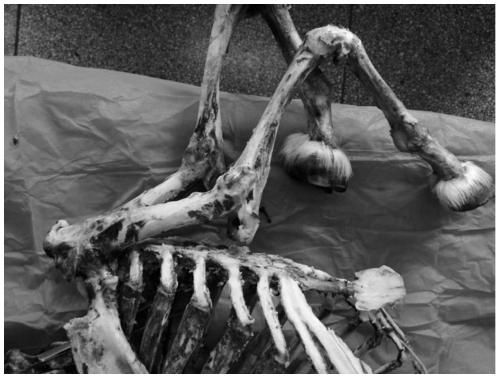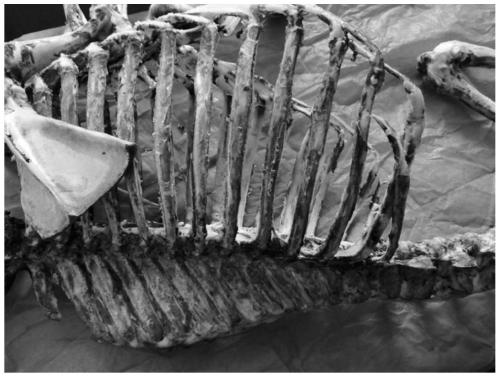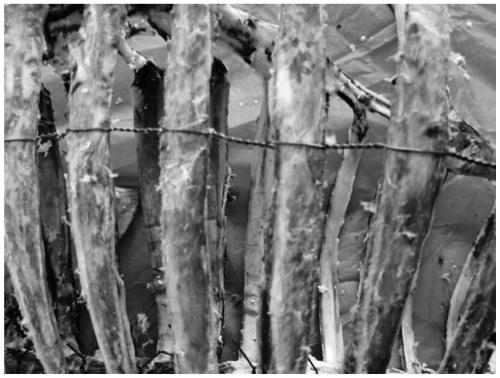Preparation method of animal whole-body bones and connected entirety specimen thereof
A specimen and whole-body technology, applied in the preservation, application, and animal husbandry of human or animal bodies, can solve the problems of time-consuming production and difficult placement, and achieve the effect of simple preparation methods
- Summary
- Abstract
- Description
- Claims
- Application Information
AI Technical Summary
Problems solved by technology
Method used
Image
Examples
Embodiment 1
[0078] A 2.5 kg dead goat with a fat content of 25 wt% and no deformity was used as the animal carcass to be processed. Inject 10 mL of 10 mL into the joint capsule cavity, around the joint, and into the spinal canal of the cadaver, and select 10 points on both sides of the spinal column, and inject 50 mL of 30% formaldehyde solution in each.
[0079] Prepare two plexiglass corrosion tanks slightly larger in length and width than the specimen, and open a rubber piston hole on the bottom of the corrosion tank, one of which is used for corrosion and the other for rinsing the specimen. Take a specimen supporting plate with a thickness of 1 mm that is slightly smaller than the corrosion tank, drill a few small holes at both ends of the supporting plate, and tie corrosion-resistant electric wires to move the specimen.
[0080] Remove the fur from the animal carcass to be treated, cut the thicker part of the soft tissue and save the joint.
[0081] Then part of the specimen after j...
Embodiment 2
[0085] A goat carcass of 26.5 kg with a fat content of 30 wt% that died from non-trauma and no deformity was used as the animal carcass to be processed. Inject 10 mL of 10 mL into the joint capsule cavity, around the joint, and into the spinal canal of the cadaver, and select 10 points on both sides of the spinal column, and inject 50 mL of 30% formaldehyde solution in each.
[0086] Prepare two plexiglass corrosion tanks slightly larger in length and width than the specimen, and open a rubber piston hole on the bottom of the corrosion tank, one of which is used for corrosion and the other for rinsing the specimen. Take a specimen supporting plate with a thickness of 1 mm that is slightly smaller than the corrosion tank, drill a few small holes at both ends of the supporting plate, and tie corrosion-resistant electric wires to move the specimen.
[0087] Remove the fur from the animal carcass to be treated, cut the thicker part of the soft tissue and save the joint.
[0088] ...
Embodiment 3
[0092] A 1.8 kg non-traumatic dead rabbit carcass with a fat content of 30 wt% and no deformity was used as the animal carcass to be treated. Inject 10 mL of 10 mL into the joint capsule cavity, around the joint, and into the spinal canal of the cadaver, and select 10 points on both sides of the spinal column, and inject 50 mL of 28% formaldehyde solution in each.
[0093] Prepare two plexiglass corrosion tanks slightly larger in length and width than the specimen, and open a rubber piston hole on the bottom of the corrosion tank, one of which is used for corrosion and the other for rinsing the specimen. Take a specimen supporting plate with a thickness of 1 mm that is slightly smaller than the corrosion tank, drill a few small holes at both ends of the supporting plate, and tie corrosion-resistant electric wires to move the specimen.
[0094] Remove the fur from the animal carcass to be treated, cut the thicker part of the soft tissue and save the joint.
[0095] Then part o...
PUM
| Property | Measurement | Unit |
|---|---|---|
| Diameter | aaaaa | aaaaa |
Abstract
Description
Claims
Application Information
 Login to View More
Login to View More - R&D
- Intellectual Property
- Life Sciences
- Materials
- Tech Scout
- Unparalleled Data Quality
- Higher Quality Content
- 60% Fewer Hallucinations
Browse by: Latest US Patents, China's latest patents, Technical Efficacy Thesaurus, Application Domain, Technology Topic, Popular Technical Reports.
© 2025 PatSnap. All rights reserved.Legal|Privacy policy|Modern Slavery Act Transparency Statement|Sitemap|About US| Contact US: help@patsnap.com



